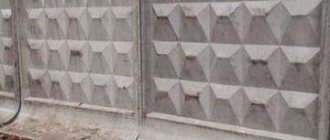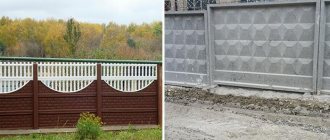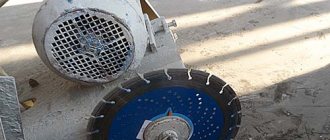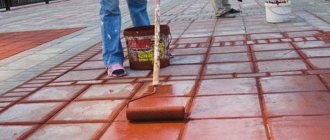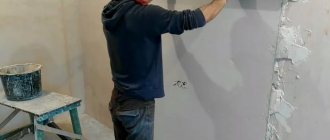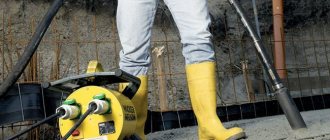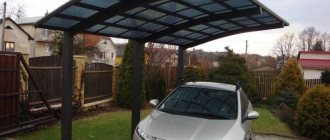Asphalt concrete is a modern, reliable material that is used for landscaping urban and private areas. Asphalt is used for sidewalks, laying driveways, road surfaces, playgrounds, etc. Asphalt concrete coatings are characterized by high quality, strength and durability.
When laying asphalt concrete sidewalks, special importance is given to the choice of material, design of work and technology for constructing the sidewalk. As a result, if all rules and requirements are followed, you will get a comfortable and safe coating that will last for many years.
Below we will look in detail at typical designs of sidewalks made of asphalt concrete, find out their advantages and disadvantages, and also analyze the technology of laying sidewalks with our own hands.
DESIGN OF ASPHALT CONCRETE COVERINGS FOR PEDESTRIAN AREA. UNITS, STRUCTURES.
We will contact you within 10 minutes!
ORDER A CALL BACK
The asphalt concrete pavement of the pedestrian zone is installed on cement concrete bases, as well as in the form of cement concrete monolithic and prefabricated pavements.
Asphalt concrete pavements on cement concrete bases are a two-layer asphalt concrete pavement with a total thickness of 13 cm, arranged on a base made of class B15 concrete from rigid rolled concrete or cast mixtures or B12.5 with an increase in the calculated thickness of the cement concrete base. The crack resistance of asphalt concrete pavement is increased by laying a high-modulus polyester reinforcing mesh over the bottom layer of asphalt concrete (over the entire area).
In this case, reinforcement bars are additionally laid over the joints in concrete.
Asphalt concrete structures can be fundamentally divided into two types:
- a design intended for the installation of sidewalk coverings up to 3.0 m and designed for vehicle loads with axle pressure up to 5.5 tons;
- a design intended for the construction of sidewalks of 3.0 m or more and designed for a vehicle load with an axle pressure of 7.0 tons.
ROAD PAVEMENT STRUCTURES FROM ASPHALT CONCRETE
The design of an asphalt concrete pavement with a pedestrian sidewalk width of up to 3.0 m, designed for vehicle loads with an axle pressure of up to 5.5 tons.
The thickness of the sand layer is determined by calculation depending on the soil, see Table 1
The design of asphalt concrete pavement with a pedestrian sidewalk width of 3.0 m or more,
designed for vehicle loads with axle pressure up to 7.0 tons.
Pavement design designed for vehicle loads with axle pressures of up to 16.0 tons.
Interface unit for asphalt concrete and concrete paving slabs
(natural stone tiles)
1. In the case of mating asphalt concrete pavement with concrete tiles, it is possible to use
concrete paving stones as a separator.
2. Road pavement structures are calculated based on the expected load on the designed surface.
3. The thickness of the sand layer is determined by calculation depending on the soil (see Table 1).
Unit diagram of the device for connecting asphalt concrete pavement and lawn
Unit for installing a drainage tray in asphalt concrete adjacent to the side stone
Sand layer thicknesses for pedestrian areas and sidewalks without drainage
Source: ALBUM OF STANDARD SOLUTIONS (STANDARDS) FOR COMPREHENSIVE IMPROVEMENT OF THE TERRITORY OF “OUTPUT” HIGHWAYS OF THE CITY OF MOSCOW.
I. SCOPE OF APPLICATION
I. SCOPE OF APPLICATION
1.1. A standard technological map (hereinafter referred to as TTK) is a comprehensive regulatory document that establishes, according to a specific technology, the organization of work processes for the construction of a structure using the most modern means of mechanization, progressive designs and methods of performing work. They are designed for some average operating conditions. The TTK is intended for use in the development of Work Projects (WPP) and other organizational and technological documentation, as well as for the purpose of familiarizing (training) workers and engineers with the rules for carrying out a set of works for constructing a sidewalk with asphalt concrete pavement in residential buildings, with a width pedestrian part of the sidewalk 1.5 m.
Fig.1. Asphalt concrete pavement design
1.2. The map shows a diagram of the technological process, outlines optimal solutions for constructing a sidewalk with asphalt concrete pavement, provides data on quality control and acceptance of work, industrial safety and labor protection requirements during the production of work.
1.3. The regulatory basis for the development of a technological map is:
— building codes and regulations (SNiP, SN, SP);
— factory instructions and technical conditions (TU);
— standards and prices for construction and installation work (GESN-2001, ENiR, VNiR, TNiR);
— production standards for material consumption (NPRM);
— local progressive norms and prices, norms of labor costs, norms of consumption of material and technical resources.
1.4. The purpose of creating the TC is to describe solutions for the organization and technology of constructing sidewalks with asphalt concrete pavement in order to ensure their high quality, as well as:
— reduction of construction duration;
— ensuring the safety of work performed;
— organizing rhythmic work;
— rational use of labor resources and machines;
— unification of technological solutions.
1.5. On the basis of the TTK, as part of the PPR (as mandatory components of the Work Project), Working Technological Maps (RTK) are being developed for the implementation of certain types of work on the installation of sidewalks with asphalt concrete pavement.
Working technological maps regulate the means of technological support and the rules for performing technological processes during the production of work. Design features for the construction of sidewalks with asphalt concrete pavement are decided in each specific case by a working design. The composition and degree of detail of materials developed in the RTK are established by the relevant contracting construction organization, based on the specifics and volume of work performed. The RTK is reviewed and approved as part of the PPR by the head of the General Contracting Construction Organization.
1.6. The technological map is intended for work producers, foremen and foremen performing work on the installation of sidewalks with asphalt concrete pavement, as well as the Customer’s technical supervision workers and is designed for the specific conditions of work in the 2nd road-climatic zone.
The technological map should be used for the following scopes of work:
— installation of concrete side stones
- sandy underlying layer
— base made of crushed stone M 600
- coating made of fine-grained asphalt concrete mixture
— area of asphalt concrete pavement 1.5x100 m
Technology for laying asphalt (road surface)
Landscaping is a serious matter. And although it is almost certain that asphalt specialists will be involved in laying asphalt in your yard or at your factory, it will be useful for you, as the owner-customer, to know the basic principles and stages of landscaping work in order to assess the professional level of your contractors and to simply navigate the process.
So, it all starts with marking or breaking down the territory - you need to determine where the asphalt will lie, where the curbs will be, where and how the drainage and collection of rainwater will be arranged. It is also necessary to determine the composition of the asphalt concrete pavement from the very beginning. Depending on the upcoming operating mode, the thickness of the crushed stone base and the number of asphalt layers are selected. If only pedestrian loads and occasional passenger traffic (sidewalks, courtyards, parking lots) are expected in the landscaped area, then you can limit yourself to a crushed stone base with a thickness of 10–15 cm and one layer of asphalt 4–5 cm. If the traffic movement is systematic and even possible movement of heavy trucks (road sections, gas stations, industrial areas), then the crushed stone base should be 25 - 35 cm, asphalt 2 - 3 layers.
The work itself begins with a device, the so-called earthen trough. New asphalt pavement should generally be flush with the rest of the surface, so all layers of crushed stone and asphalt should go deeper. Therefore, throughout the entire territory, soil is selected to a depth equal to the total thickness of the future coating. After the soil has been selected, it is advisable to compact the bottom of the trough by walking over it with a road roller or vibrating plate.
The next stage of improvement is the installation of a crushed stone base. If your base is 10 - 15 cm, then crushed stone of a fraction of 20-40 mm is usually used for it. It is recommended to make a more serious base with two or three layers. For the bottom layer, large crushed stone of a fraction of 40-70 mm is taken. The function of this layer is to drain water in case of rising groundwater. For the second layer, crushed stone of a fraction of 20-40 mm is taken, it serves to more evenly distribute the load on the base. For the third layer of crushed stone base, crushed stone of a fraction of 5-20 mm is required. Depending on the thickness, it performs a number of functions. If its thickness is 2-5 cm, then we can talk about the splitting of the upper part. When the thickness of the third layer is up to 10 cm, we are talking not only about declinging, but also about uniform distribution of the load over the entire base. When laying, each layer of crushed stone must be carefully compacted with a roller. The skating rink should pass through one place 5-6 times.
In the case of asphalt concrete pavement intended for high loads, rollers of 6-10 tons or higher must be used to compact the base and then the asphalt concrete. For smaller loads, rollers of 2-4 tons are sufficient. It should be remembered that in modern rollers the vibration function significantly increases the compaction ability (about 3-4 times!). Vibrating plates and vibrating rammers can also be used for compaction in hard-to-reach places. To improve the quality of compaction, the base should be moistened. At large facilities, watering machines are used for this.
At the stage of foundation construction, a slope must be set throughout the asphalted area in the direction where rainwater collection is planned. Typically, a slope of 5-10 mm per 1 m is set. Levels are used to determine the slope and control the thickness of layers of crushed stone and asphalt concrete.
Before laying asphalt, it is also necessary, if provided, to install curbs, install storm drains, build or repair sewer or drainage wells, install or raise hatches, etc.
After the preparatory work has been completed, you can proceed directly to asphalt paving. The thickness of the asphalt concrete pavement, as well as the thickness of the crushed stone base, depends on the intensity of the planned operation. For the adjacent territory of an ordinary residential high-rise building, where the movement of trucks is not planned, you can get by with one layer of fine-grained asphalt 4-5 cm thick. For more serious conditions, it is necessary to lay two layers of asphalt - the lower layer of coarse-grained asphalt concrete 4-5 cm thick, and the upper one - from fine-grained one, also 4-5 cm. The third layer of asphalt will remove all questions about the strength of the future coating (of course, we are not considering the case of runways now).
How to choose quality asphalt
Asphalt production is carried out by specialized enterprises, asphalt plants. Over many years of work, our company has established partnerships with many Moscow enterprises. We buy high-quality material at wholesale prices, choosing a manufacturer so that delivery to the site takes a minimum of time.
For asphalting at a low price, you can use recycled material, asphalt chips. Crumbs are prepared from the old coating. Pieces of removed asphalt are crushed to obtain crumbs of the desired size. The addition of a bitumen component ensures the density and strength of the future asphalt surface. The surface made of asphalt chips copes well with moderate loads, ideal for creating pedestrian paths, decorating courtyards and local areas in dachas, country cottage villages and cities.
Depending on the type of asphalt work, materials of different compositions are used. For the road surface you need durable asphalt from M1200, for sidewalks the M100 grade is sufficient. There are special requirements for covering pedestrian areas.
- Asphalt must have high wear resistance and abrasion resistance.
- A high level of strength and rigidity is required.
- A rough anti-slip surface is required to ensure reliable adhesion to shoes.
- The coating is not afraid of moisture.
- Does not crack at sub-zero temperatures.
In addition to technical requirements, it is important to obtain an even and uniform color coating. Asphalting paths in a dacha or suburban area by our company guarantees an aesthetic result.
What should be the thickness of crushed stone for asphalt?
If we talk about roads on which cars drive, including multi-ton trucks, and not about pedestrian paths, then the preparation technology before laying asphalt is much more complicated. If the fertile layer of soil has already been removed and the sand cushion has already been compacted, then the next stage will be crushed stone flooring. Crushed stone will be required in different fractions. The total layer should be 25-35 cm. The first layer of crushed stone should be from a fraction of 40-70 mm. It will also serve as drainage from groundwater. It will be about 20 cm. The next layer of the 20-40 mm fraction is 5-10 cm thick. This smaller crushed stone will ensure even distribution of the load when rolling the road. Many builders also lay down a third layer from a fraction of 5-20 mm up to 5 cm thick. Now you can lay the asphalt.
The thickness of the cushion of crushed stone and asphalt layer depends on the expected load on the road surface. If the asphalt path is for pedestrians and cyclists, then a thickness of a layer of crushed stone (middle fraction) of 15 centimeters is sufficient, on which only one layer of asphalt is laid.
How to lay new asphalt on an old surface?
Renewing an old coating is easier than making a new one. If there is already asphalt at the site of the proposed paths, which has become unusable, the material can be laid on it. There is no need to completely remove the old layer for this. It is enough to clean it from dirt and dust. Before laying a new surface, the asphalt must be thoroughly dried.
A continuous layer of fresh bitumen is applied along the edges of the entire area. Then the asphalt is laid using the technology described above.
Paving technology
The final stage is laying asphalt, which is thoroughly mixed with fine sand and stone flour. This mixture is heated to the desired temperature and laid in layers. Each of them should be approximately seven centimeters thick. An asphalt paver is used during the laying process. This serious equipment is equipped with many sensors and its own computer. Upon completion of the process, the finished coating is again watered with bitumen emulsion.
- Hot type coatings. They are laid at temperatures above 140 degrees. This requires special equipment. Hot asphalt pavement is highly durable, so it is used for laying roads, city streets and squares.
- Cold asphalt. This type of mixture is also called warm, and it is prepared using bitumen, which has a reduced viscosity. Cold material is laid at a temperature of 80 to 120 degrees. Asphalt coatings of this kind are most often used in courtyards, playgrounds, sidewalks and other places that are not subject to heavy loads.
Where to get asphalt
It is almost impossible to make asphalt at home, despite the simplicity of the technology and the simple composition of the material. It is better to leave this matter to specialized enterprises that have special production capabilities and appropriate equipment for these purposes.
Therefore, it would be more rational to order ready-made asphalt of the appropriate type from these enterprises and, in addition, the product will be delivered to your destination and all you have to do is distribute it at the installation site, roll it out and compact it.
There is another option for purchasing asphalt - using used material. On the one hand, it will cost even less, but on the other, the process of reviving old raw materials will take more time and effort.
For reference: one ton of fine-grained asphalt type 3 in Moscow costs about 3,000 rubles/t. You will have to pay extra for delivery or you can pick it up yourself.
Road works technologies
Proportions and manufacturing standards are regulated by GOST, but many manufacturers ignore this rule and use cheap substitutes. This does not reflect well on the quality of the asphalt mixture, so it is preferable to order this product from truly trusted companies, for example, representative offices.
- First class coatings. They are used for laying routes and can withstand heavy loads. The technology involves the use of mineral filler up to four centimeters in size. Such coatings can withstand the weight of loaded vehicles and intensive use.
- Second class coatings. They are used for paving squares, sidewalks and pedestrian roads. The largest inclusions of the asphalt mixture reach 25 mm.
- Third class coatings. The priority in this case will be the plasticity of the mixture. Mineral particles of minimal size (up to 15 mm), which allows for a tight fit of the composition. This type of coating is used for non-vehicular use (private courtyards, institutional areas, sports grounds).
Laying asphalt
As soon as the asphalt is delivered to you by dump truck, you must immediately begin laying it. You can use an asphalt paver for these purposes. Narrow paths are covered with asphalt using a shovel, and then compacted using a vibrating plate. Based on the thickness of the asphalt, immediately after spreading it over the surface, compaction should immediately begin with self-propelled or manual devices.
2. Preparing the base for laying asphalt. In order to do a good asphalt laying with your own hands, you need to lay a solid foundation. The base for the road surface can be rigid (road slabs) or flexible (sand, crushed stone or gravel). If the load on the coating is low with low traffic intensity, these base parameters will suit you. In the area of the entrance to the house, pour crushed granite stone of a fraction of 40 - 60 mm . (layer thickness 15 cm). For pedestrian paths and areas, an embankment of 5-10 cm will be sufficient. Crushed stone requires compaction and compaction, as well as uniform distribution. It is important to note that laying a larger layer is not advisable. After laying coarse crushed stone, it is followed by laying granite crushed stone of a smaller fraction of 20 - 40 mm. Its thickness is about 10 cm, the last layer is river sand. It is advisable to spill the entire flooring with water so that it settles and becomes more durable.
Preparatory stage
Before the start of construction work on laying asphalt concrete, the dimensions of the sidewalk, its boundaries and the place where it will pass are determined. It is important that no large trees grow at the site of future work, as their roots may damage the coating in the future.
The selected location is thoroughly cleaned, bushes and trees (if any) are uprooted, and all debris is removed. Then the boundaries of the track are marked.
Preparing the base
It is necessary to dig a “bathtub” within the specified boundaries of the sidewalk. To do this, the top layer of soil about 30 cm thick is removed and thoroughly compacted.
The next step is to install the side curbs. Curbs have two main purposes - to aesthetically design the boundaries of the sidewalk and to keep the asphalt concrete solution from spreading during laying work.
Curb installation process:
- Dig parallel trenches on both sides of the path;
- Pull the control thread along which the curb elements will be laid;
- Lay bricks or other selected materials on the cement mortar.
Preparing a sand-crushed stone bed
After laying the curbs, work begins on forming the crushed stone cushion.
- A layer of sand is poured onto the prepared base; its thickness should be 15 cm. The sand is leveled (evenness can be checked with a building level) and thoroughly compacted;
- A layer of coarse crushed stone is poured onto the sand layer and compacted well;
- Waterproofing is laid on the resulting base;
- Fine crushed stone or gravel is poured over the waterproofing layer and leveled;
- The layers are filled with water and compacted; the water will ensure that the layers adhere tightly to each other.
It is necessary to construct drainage holes in advance to prevent rainwater from accumulating on the sidewalk.
Asphalting the yard of a private house: more about the process
When the base is ready for asphalting, the asphalt mass must be poured into several small piles. This is done to ensure uniform distribution over the paved area of the yard. Next, the mass needs to be scattered with a shovel and distributed evenly on all sides: 5 cm thick in the yard and pedestrian paths, 10 cm in places of car passages.
For example, if an area near a house is being prepared for parking and driving a car, then it is necessary to asphalt it in two layers, and the crushed stone base should reach from 25 cm to half a meter. And when paving pedestrian paths, you don’t have to build a serious foundation; only 10 cm of crushed stone is enough, so asphalt paths will cost several times less.
The process of paving sidewalk paths
The technology for laying asphalt for sidewalks and pedestrian paths is no different from asphalting a road surface. Experts use two types of asphalt concrete:
- Hot asphalt - used to lay a new road surface.
- Cold asphalt is most often used for repair work.
Work with cold asphalt concrete can be carried out in any weather and at any time of the year. You can purchase cold asphalt at the store and perform pothole repairs yourself.
Asphalt paving work is carried out in several stages. For the best result, the correct sequence of actions must be strictly followed.
- Site marking;
- Preparation of the base;
- Installation of curbs;
- Creation of a sand-crushed stone cushion;
- Emulsion treatment;
- Laying asphalt.
Roads in the courtyards of apartment buildings: who should repair them
It is no secret that state and municipal authorities in Russia work extremely slowly, and road surface repairs often drag on for months, or even more. It happens that your request to repair the road, sent to the competent authority, will be completely ignored.
So, first you need to find the entity whose property is the road, the section of which needs repair. If the road is included in the local area, then it belongs to the common shared ownership of the house, i.e. the management company will be responsible for its operation, and therefore repairs (see Decree of the Government of the Russian Federation No. 491).
Technology for laying asphalt (road surface)
In the case of asphalt concrete pavement intended for high loads, rollers of 6-10 tons or higher must be used to compact the base and then the asphalt concrete. For smaller loads, rollers of 2-4 tons are sufficient. It should be remembered that in modern rollers the vibration function significantly increases the compaction ability (about 3-4 times!). Vibrating plates and vibrating rammers can also be used for compaction in hard-to-reach places. To improve the quality of compaction, the base should be moistened. At large facilities, watering machines are used for this.
So, it all starts with marking or breaking down the territory - you need to determine where the asphalt will lie, where the curbs will be, where and how the drainage and collection of rainwater will be arranged. It is also necessary to determine the composition of the asphalt concrete pavement from the very beginning. Depending on the upcoming operating mode, the thickness of the crushed stone base and the number of asphalt layers are selected. If only pedestrian loads and occasional passenger traffic (sidewalks, courtyards, parking lots) are expected in the landscaped area, then you can limit yourself to a crushed stone base with a thickness of 10–15 cm and one layer of asphalt 4–5 cm. If the traffic movement is systematic and even possible movement of heavy trucks (road sections, gas stations, industrial areas), then the crushed stone base should be 25 - 35 cm, asphalt 2 - 3 layers.
II. GENERAL PROVISIONS
2.1. The technological map has been developed for a set of works on the installation of sidewalks.
2.2. Work on the installation of sidewalks is carried out in one shift, the duration of working hours during the shift is:
where 0.06 is the coefficient of reduction in efficiency due to an increase in the duration of the work shift from 8 hours to 10 hours, as well as time associated with preparation for work and carrying out technical maintenance, breaks associated with the organization and technology of the production process and rest for construction machine operators and workers - 10 minutes every hour of operation.
2.3. The work sequentially performed during the construction of the sidewalk includes the following technological operations:
— geodetic marking works;
— excerpting a trough for foundation construction and compaction of foundation soil;
— installation of side stones;
— arrangement of a sandy underlying layer;
— construction of a crushed stone base;
— priming the base with liquid bitumen;
— installation of asphalt concrete pavement.
2.4. The technological map provides for the work to be performed by a complex mechanized unit consisting of: JCB 3CX m backhoe loader
, (excavator bucket volume 0.48 m, jaw loading bucket volume 1.0 m)
self-propelled, sidewalk, vibrating, tandem roller DM 02
(operating speed up to 8.0 km/h, operating weight 1.5 tons);
watering machine PM-3U
(tank volume 6000 l);
asphalt distributor DS-39B
(tank volume 4000 l);
paving asphalt paver VOGELE SUPER BOY
(laying strip width from 1.2 to 3.1 m, asphalt paver weight 4.7 tons, operating speed 20 m/min, receiving hopper volume 5.0 tons) as a driving mechanism.
Fig.1. Working area of the JCB 3CX m backhoe loader
— Maximum digging depth — 5.97 m; — The maximum reach of the bucket from the axis of the rear axle is 7.87 m; — The maximum reach of the bucket from the axis of the steering column is 6.52 m; — The reach of the bucket from the axis of the steering column at the maximum lifting height is 3.66 m; — The maximum reach of the bucket from the machine axis when the boom is rotated by 90° is 7.09 m; — Maximum lifting height of the bucket — 6.35 m; — Maximum unloading height — 4.72 m; — Unloading height — 2.74 m; — The height of the horizontal bottom is 3.20 m; — The height of the bucket hinge axis is 3.45 m; — Reach of the bucket hinge axis — 0.36 m; — Reach of the bucket edge at ground level — 1.42 m; — The maximum reach of the raised bucket is 1.20 m; — Reach of the raised bucket during unloading — 0.83 m; — Digging depth (thickness of the cut layer) — 0.10 m; — Bucket tilt angle — 45°; — Unloading angle — 43°; Jaw opening width - 0.95 m
Fig.2. Overall dimensions of the JCB 3CX m backhoe loader
— Overall length — 5.62 m; — Wheelbase — 2.17 m; — The distance from the axis of the steering column to the rear axle of the bridge is 1.36 m; — Ground clearance from supports — 0.37 m; — Ground clearance from the turning column — 0.52 m; — The height of the center of the steering wheel is 1.94 m; — Cabin roof height — 2.87 m; — Overall height — 3.61 m; — Overall width along the support frame — 2.36 m; — Loader bucket width — 2.35 m
Fig.3. Sidewalk roller DM 2
What thickness of asphalt should be in the yard
Next, the base is prepared, for which crushed stone corresponding to the thickness of the layer is used (for a layer of 10-15 cm, for example, crushed stone of a 20-40mm fraction is used). When preparing a fairly serious base, a multi-layer laying method is used - the bottom layer is laid with crushed stone of a fraction of 40-70 mm, the top layer is laid with smaller ones, for the correct and uniform distribution of loads over the entire base. For the third layer, fine crushed stone, fractions 5-20 mm, is used. Each layer must be thoroughly compacted with an asphalt roller, running it over each area 5-6 times.
The asphalt laying technology also involves the use of various rollers - for pavements designed for high loads, rollers weighing 6-10 tons are used; for pavements with lower endurance requirements, a roller weighing 2-4 tons is sufficient. Also, do not forget about modern rollers equipped with a vibration function, which increases compaction efficiency several times.
Modern methods of laying asphalt pavement
Asphalt belongs to the group of building materials intended for covering road surfaces. Its main purpose is to create reliable safe conditions for organizing pedestrian or vehicular traffic.
When properly laid, asphalt pavement can withstand heavy loads, this is facilitated by the grade of asphalt, which is legally established by GOST 11-10-75: M1200 - for roads, M1000 - for sidewalks and paths.
Asphalt is environmentally friendly, has a high level of practicality and an attractive appearance, is somewhat labor-intensive to manufacture and use, and is not the most expensive of road surfaces.
Advantages and disadvantages of asphalt pavement
Asphalt pavement has gained great popularity due to a large list of positive qualities, among which are the following:
- Affordable price - all materials can be purchased in the store and you can make the solution yourself;
- Speed of laying and drying of the coating - work is carried out in a short time, complete drying of the asphalt occurs after a couple of days;
- Simplicity of repair work - just remove the deformed part and lay cold asphalt in its place and compact it thoroughly;
- Appearance – the coating is even and smooth, you can choose the desired color or shade;
- Strength and resistance to deformation;
- Water resistance.
The main disadvantage of asphalt concrete pavements is the unpleasant odor from bitumen fumes, which can appear in hot weather.
Types and composition of asphalt
There are two types of asphalt used to cover roads: cold and hot. The composition of any type will be the same, the difference lies in the percentage of components.
The components of asphalt are:
The percentage of components depends on the road for which purpose the coating will be laid.
GOST 11-10-75 recommends using the cold laying method for repairing main roads, in courtyard areas, and for constructing sidewalks.
Hot paving of asphalt is a method by which a new road surface is formed by compacting the mixture before it hardens.
Construction of sidewalks made of asphalt and asphalt concrete
Asphalt concrete is a modern, reliable material that is used for landscaping urban and private areas. Asphalt is used for sidewalks, laying driveways, road surfaces, playgrounds, etc. Asphalt concrete coatings are characterized by high quality, strength and durability.
When laying asphalt concrete sidewalks, special importance is given to the choice of material, design of work and technology for constructing the sidewalk. As a result, if all rules and requirements are followed, you will get a comfortable and safe coating that will last for many years.
Below we will look in detail at typical designs of sidewalks made of asphalt concrete, find out their advantages and disadvantages, and also analyze the technology of laying sidewalks with our own hands.
Possible defects in asphalt pavement
Asphalt laying work on main roads may be accompanied by some defects appearing on the surface if the asphalt paving rules are violated.
When using a paver, short waves may appear on the pavement. In this case, you need to ensure a uniform supply of the hot mixture. Long waves will indicate that the temperature of the mass is not maintained or the roller is moving unevenly.
Tears may form on the canvas, which will be a consequence of improper operation of the screed plate. It will violate the compaction coefficient due to inappropriate temperature of the mass and the presence of foreign inclusions in it. In this case, it is necessary to strictly control the operation of the laying equipment; isolated small breaks can be eliminated immediately.
Temperatures above the norm approved by SNiP can lead to cracking or uneven surface texture due to the sharp contrast between the base and the hot mass.
Bitumen stains appearing on the surface are a consequence of a violation of the percentage composition of the mixture. They will make the surface slippery. Precise adherence to proportions will prevent this defect.
Poor quality seams are the rules of installation. To avoid them, the cold edge is heated with gas burners, and only then the hot mixture is laid.
Incorrect operation of the asphalt paving machine can result in different layer thicknesses or longitudinal cracks, so the equipment must be well adjusted.
What is the difference between asphalt and asphalt concrete?
Asphalt concrete mixture is an artificial material that is obtained by mixing solid ingredients with petroleum road bitumen.
Natural asphalt is formed in the process of thickening and oxidation of oil that has come to the surface of the earth in the form of reservoir deposits, individual veins or lakes.
The word “asphalt” translated from ancient Greek means mountain tar. It is a fusible black substance. The fracture is conchoidal, matte or shiny. Contains up to 70% petroleum bitumen.
The largest sources of natural asphalt are the Dead Sea in Israel and Peach Lake in Trinidad. The ancient Syrians mined hard bitumen, which floated to the surface in huge blocks, the weight of which reached 1000 kg.
Mountain resin was used for waterproofing ships, hut walls, granary floors, and for making paints or varnishes. In Ancient Egypt, the substance was used to embalm the dead.
Natural asphalt supplies are limited. Painting paints and paint products are made from high-quality raw materials. In road construction, when installing an asphalt concrete surface covering, part of the liquid bitumen is replaced with solid bitumen. At the same time, the resistance to the effects of studded tires is significantly increased.
